Mussid corals are high on my list of favorite corals for many reasons. Most are easy to care for, they have large fleshy polyps, commonly with fluorescent colors, they respond dramatically to food additions, and they are relatively slow growing so they don’t require frequent pruning. They are also not especially aggressive. For these reasons they are popular among aquarists, who know them as, among other names, Doughnut coral, Flat Brain coral, Modern Meat Coral, or just Meat coral. The meaty association is a reference to the polyps’ fleshiness and also to the common red coloration.

Scolymia cubensis from Brazil. Bright fluorescent green is the most common color, but they may also be gray, brown, red, or multi colored.

Scolymia australis from Australia, left with Scolymia cubensis from Brazil, right. The differences in the dentation of the septo-costae may suggest that they don’t belong to the same genus. The dentation on S.cubensis is like Mycetophyllia danaana, while the dentation on S. australis is like Lobophyllia spp.

This is a typical example of Scolymia vitiensis from the Solomon Islands. Note the exposed skeleton which shows how little the tissue is actually expanded and how flat the corallum is.

This coral from Tonga is probably a multicentered Scolymia vitiensis, but it could also be a small Australomussa rowleyensis. There is not much difference between them.

Typical skeleton of a small (3cm) Cynarina lacrymalis. The crown of paliform lobes can be seen around the center of the polyp.
A group of related genera of mussids have produced a confusion of identity among aquarium hobbyists that is not surprising. The scientific literature about them is full of confusion as well because the appearance of the living polyps and skeletons is often so similar between species or genera, or so different WITHIN species and genera, that lines of distinction can seem blurry. With this article I intend to sort out the differences among Cynarina and Scolymia species, to help clarify their identification. The article will also serve to point out in greater detail some taxonomical revisions I suggested in the second and later editions of my book Corals: A Quick reference Guide. I will also propose a few new ideas about how these difficulties could be sorted out. The reader should be careful to note that the revisions I am suggesting here have not been applied to the present taxonomy.
What is Scolymia?
The genus Scolymia consists of two recognized species in the Indo-Pacific region and one in the Caribbean. The Indo Pacific forms are S. vitiensis, which is common, and S. australis, which is uncommon. Scolymia australis is not easily distinguished from small solitary polyps of Lobophyllia hemprichii, Lobophyllia robusta, and Symphyllia valenciennesi, so that small round polyps that appear to be Scolymia australis often are not. In the Caribbean a similar problem exists for the coral Mussa angulosa, (which is basically a Caribbean species of Lobophyllia ). Solitary polyps of Mussa were once called Scolymia lacera. Fenner (1993) recognized this synonymy and this left one species, S. cubensis a.k.a. S. wellsi, which occurs in Florida and the Caribbean, and becomes abundant in Brazil. In Florida and the Caribbean there is another Scolymia-confusing coral: Mycetophyllia danaana. Newly settled single polyps of this coral especially, as well as its sister species Mycetophyllia aliciae, are round and fleshy and often indistinguishable from Scolymia cubensis. As Mycetophyllia danaana grow, they form new centers and lobes so that a many lobed flat colony forms. It could be argued that true Scolymia cubensis is really just a solitary polyp forming species of Mycetophyllia. That logic could similarly be used with S. australis, which could be simply a solitary polyp species of Lobophyllia. Where would that leave Scolymia vitiensis? That species is distinctively different from the other two, being flatter, larger, and not as fleshy as the others. It can occur as solitary polyps or with multiple centers. The colonies with multiple centers are practically indistinguishable from another mussid genus, Australomussa. Following the logic of my earlier groupings, Scolymia vitiensis could simply be a species of Australomussa. Since the name Scolymia is older than Australomussa, there is a bit of a problem with this idea, since the convention of nomenclature gives precedence to the older names. A revision could eliminate the genus Australomussa, changing it to Scolymia. Thus there would be Scolymia rowleyensis, and Scolymia vitiensis would remain unchanged. The other species of “_Scolymia_” would be synonymized as follows: Mycetophyllia cubensis, Lobophyllia australis.
It is important to point out that these revisions are just musings on my part, albeit with valid reasoning. The most current taxonomical status of these corals is represented in Veron (2000).
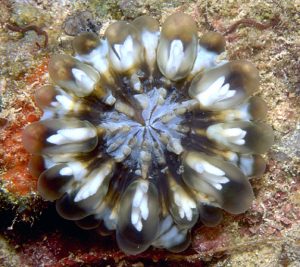
A typical example of Cynarina lacrymalis. Note the vesicles, the clearly visible dog-tooth shaped septo-costae, and the crown of paliform lobes at the center of the polyp.
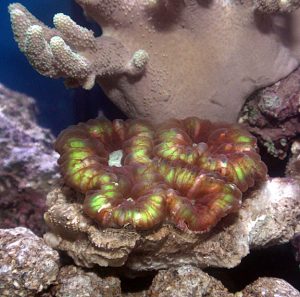
This specimen of Cynarina lacrymalis with several centers was photographed in an aquarium belonging to Sea Dwelling Creatures.

What I call the “Hybrid form” of Cynarina lacrymalis photographed in an aquarium belonging to Sea Dwelling Creatures. Note the lack of dentation on the primary septo-costae and the low crown of paliform lobes.

This is the typical appearance of the polyp of Indophyllia macassarensis. It should be obvious why the author suggests the name should be revised to Cynarina macassarensis.
What is Cynarina?
The history of Cynarina naming is long and almost as thorny as the skeleton of this genus. The confusion in the scientific literature is on many levels. Various authors have proposed three distinct genera for the three distinct forms, while other authors have synonymized two of the forms as one species, leaving the third form, inexplicably, as a separate genus. I have had the chance to review most of the literature and skeleton photographs, and have looked at skeletons in the collection at the Smithsonian Institution. I have also gathered some skeletons of these corals for demonstrating the key differences among the forms.
The genus Cynarina is presently recognized to be represented by one species only, C. lacrymalis (Veron, 2000). A distinct form, once classified as Acanthophyllia deshayesiana (Wells, 1937), was synonymized with C. lacrymalis, see Veron and Pichon, 1980, Veron, 1986. Sprung (2000) disputes this revision, with photos of the distinguishing features of the skeletons and polyps. Best and Hoeksema (1987) and Veron (2000) recognize another genus, Indophyllia, represented by one species, I. macassarensis, as a close relative of Cynarina. Sprung (2000) proposed that I. macassarensis should be revised to be Cynarina macassarensis. Therefore, according to Sprung (2000) there are three species of Cynarina: C. lacrymalis, C. deshayesiana, and C. macassarensis.
The fact that one can find examples of skeletons that show intermediate form between these three putative species is not unique to Cynarina. In any genus of corals one can find a spectrum of forms between species that would suggest fewer species exist. The same can be said of the identifying features of the species in various plant and animal genera. This situation is also enhanced regionally and over time, something well illustrated in Veron’s book, Corals in Space and Time, as well as in Veron (2000). For a given group of species it is also possible to say that they are distinct species in one region at a given time, but not in other regions, where the forms may merge. These facts notwithstanding, I don’t see why Cynarina lacrymalis should have special status as a lumped species when it contains two distinct (especially in Indonesia) albeit closely related forms, (Sprung, 2000). A good comparison can be made with “species” of Euphyllia, in which the skeletons often cannot be used to distinguish them, but the polyps can.
The answer to the question I pose about lumping Cynarina is given in Veron (2000), in the following points made in volume 3:
“Natural continua go beyond the taxonomic or morphological boundaries of individual species. This cannot be accommodated by creating divisions within species. The problem remains if the species unit is split into smaller units or lumped into larger units and it is not solvable by further or more detailed study. Ultimately, the only unit in Nature that is real is the syngameon.”
“Syngameons are (reproductively isolated) genetic units typically composed of many species, even genera. Species are morphological units.”
“Syngameons are not useful for taxonomic purposes. Species, to the maximum extent possible, are.”
Since humans need “species” distinctions to communicate about different types of creatures, it makes sense that taxonomists who deal with these issues must make arbitrary decisions about what a species is.
So, it is arbitrary to decide that Indophyllia is or isn’t a species of Cynarina, or to say that Acanthophyllia deshayesiana does not exist, that it is only a form of Cynarina lacrymalis. One could likewise say that all Indophyllia, Cynarina, and Acanthophyllia are just the one highly variable species Cynarina lacrymalis. One could alternatively make them three species within the genus Cynarina, which is my arbitrary preference, because I think that it most easily allows people to communicate about the three most typical forms.
Why should anyone care? I think the main issue that started my interest in this matter is that exporters in Indonesia often export the deshayesiana form as Scolymia sp. This results in occasional confiscated shipments when fish and wildlife examiners notice the skeleton is really Cynarina-like. The exporter merely attempts to clarify that the form is not the typical clear- tissued Cynarina lacrymalis, and the importer pays a penalty for this attempt at being precise. Precision is something that CITES also attempts to promote. In fact if you compared the living polyps, the tissue in the deshayesiana form is practically identical to Scolymia australis, excepting for its potential ability to inflate. One has to wonder about the function or wisdom of CITES penalties when they are based on taxonomical determinations that even taxonomists can’t agree on, which are of necessity arbitrary!
What is Cynarina?
The present definition of Cynarina refers to one species only, C. lacrymalis. It is a common and widespread coral typically found on deep reefs, shallow turbid lagoon reefs, shipwrecks, and on soft bottoms in shallow or deep water. The tissue of Cynarina lacrymalis is distinctively translucent. Even Veron (2000) describes Cynarina as having a mantle that is “translucent so that the toothed primary septo-costae are clearly seen.” The tissue forms swollen vesicles that divide it like the sections of a beach raft, sometimes swelling into rounded bubbles that resemble the vesicles in the Bubble coral, Plerogyra. Coloration is most commonly brown or gray with green fluorescent highlights and some white radiating lines or spots. Occasional specimens are bright green, red, pink, or orange, still with translucent tissue. Sometimes the fluorescent green color is located within the tissue, not on the tissue surface, so that a cat’s eye effect is achieved. The skeleton of C. lacrymalis is variable, but the most typical specimens have some common features (Sprung, 2000). The prominent septo-costae are thickened so that they look like dog teeth. At the center of the polyp there is a prominent crown of paliform lobes. The diameter of the corallum is usually not more than about 3 inches, though the expanded polyp proportions form a mantle with a diameter that may exceed 12 inches in calm water conditions.
Cynarina (=Acanthophyllia) deshayesiana
Although Acanthophyllia deshayesiana is supposed to be a synonym of Cynarina lacrymalis, (Veron, 2000), it differs from the former in several respects that contradict the definition of Cynarina lacrymalis. One difference is the appearance of the polyps. In Acanthophyllia deshayesiana the polyps are not translucent, but completely opaque. The thickness of the tissue is also greater than in C. lacrymalis, so that it has a texture like Lobophyllia spp. or Solymia australis. Polyp expansion, however, is the same as for Cynarina lacrymalis. Coloration matches the range and appearance for Scolymia australis, and as a result this coral is commonly mis- identified as Scolymia sp. The expansion of the tissue in Scolymia australis, however, does not achieve the dramatic proportions of Acanthophyllia deshayesiana or Cynarina lacrymalis. The polyp of Acanthophyllia deshayesiana also does not form the vesicles typical in Cynarina lacrymalis. Another difference is the size of the corallum. Although in some regions there does not appear to be a difference in the size of the corallum, in Indonesia the corallum of Acanthophyllia deshayesiana can be at least twice as large as that of Cynarina lacrymalis, to 6 inches in diameter (Sprung, 2000). Still another difference is the appearance of the primary septo-costae. In small and medium sized Acanthophyllia deshayesiana they are not thickened like dog teeth, but in the largest specimens they can be somewhat thickened (though still flatter than in typical C. lacrymalis ). Also, the sharp dentations on the septo-costae are typically taller than in C. lacrymalis. Another skeletal difference exists. In Acanthophyllia deshayesiana the formation of a distinct crown of paliform lobes in the center of the polyp is nearly absent, though some of the septa may have a pallus lobe (Sprung, 2000). Although I have not had the opportunity to view large numbers of polyps and skeletons from Japan and the Red Sea, the specimens I saw when I visited these two regions appeared to have one form of skeleton (like A. deshayesiana but only achieving the size of C. lacrymalis ) and two forms of polyps (like both Cynarina lacrymalis and Acanthophyllia deshayesiana ). The giant corallum forms I have only seen from Indonesia. I must point out that the “_Cynarina lacrymalis_” skeleton on page 83 in Veron (2000) and the skeletons shown in figure 8(a-c) in Borel Best and Hoeksema (1987), that originate from Komodo, Indonesia, are typical of the deshayesiana form, not the lacrymalis form. The most complete illustration of the different forms is in Sprung (2000).
What is Indophyllia?
Indophyllia macassarensis is an uncommon import from Indonesia that is typically identified as Cynarina lacrymalis. The living polyp is very similar to that of C. lacrymalis, but has a few distinguishing characteristics. First, it always has pronounced concentric wrinkles that are only weakly present in C. lacrymalis (such wrinkles are often present in C. deshayesiana ). The color of the polyp is mainly brown, with some white radiating lines, and a slight green fluorescence. The flesh has about the same consistency and opacity of C. lacrymalis, and there are some narrow transparent vesicles that radiate out from the oral region of the polyp, corresponding to but much narrower than the clear vesicles found in C. lacrymalis. The expansion of the polyp in diameter and proportion is identical with the polyp expansion of Cynarina lacrymalis and C. deshayesiana.
Borel Best and Hoeksema (1987) describe I. macassarensis as a new species, the only living representative of a genus described from fossils by Gerth (1921). They describe it as a solitary coral, attached as a juvenile but free- living in the mature stage. The skeleton diameter is a maximum of about 2 inches (45 mm). The aboral side of the skeleton has a smooth epitheca covering, a trait shared with free-living Acanthophyllia deshayesiana. The septa are evenly exsert and regularly lobed with dentation much finer and more numerous than in Cynarina lacrymalis. I have observed specimens with a skeleton of up to about 3 inches in diameter, an example of which is shown in this article.
Borel Best and Hoeksema (1987) collected the type specimens from the Makassar Strait in which the Spermonde Archipeligo, S.W. Sulawesi is located. The habitat where they occurred is on “sandy bottom under reef slopes in a depth range from 21 to 36 meters, usually on the leeward sides of islands which are sheltered from wave action.” Such areas don’t have reef development but are characterized by a diversity of free-living corals adapted to the soft bottom community.
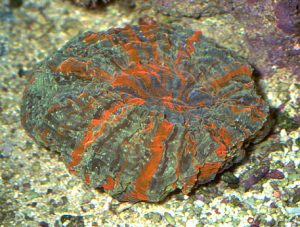
A striped specimen of Acanthophyllia deshayesiana. Note that there is no vesicle formation, the tissue is completely opaque, and the overall appearance is like Scolymia australis.
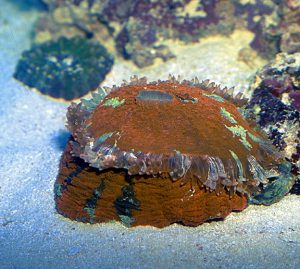
Two specimens of Acanthophyllia deshayesiana. The red one in the foreground is responding to food by expanding its tentacles while a green specimen in the background hasn’t caught the scent.
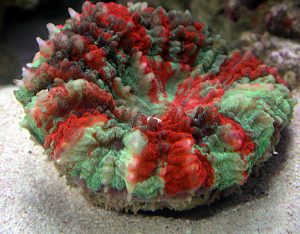
A tightly closed specimen of Acanthophyllia deshayesiana reveals the strong dentation of its septo-costae. Note that the tissue is thick like a Lobophyllia sp., and that the teeth on the septo-costae proceed to the polyp center without forming a distinct crown of paliform lobes.
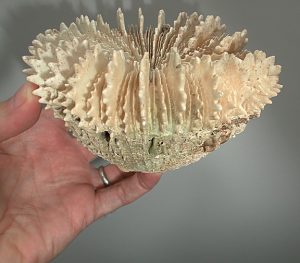
The largest skeleton of Acanthophyllia deshayesiana in the authors collection has a diameter of about 5 inches. This monster is not the largest specimen he has seen, however.
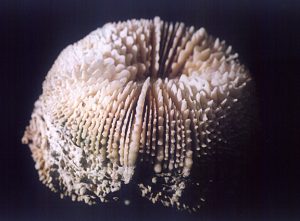
Side view of the skeleton of an Indophyllia macassarensis. Note the much more numerous teeth than on Cynarina lacrymalis.
The soft bottom habitat relates to some distinguishing features of the fossils earlier described by Gerth (1921). Indophyllia cylindrica from Java has a cylindrical corallum when mature and flattened disc-like corallum when young. It should be obvious to anyone familiar with the soft bottom habitat that these distinctions relate to adaptation and survival in this habitat. Laboute (1988) describes skeletal, polyp, and behavioral adaptations for stony corals living on a soft bottom in New Caledonia. In such a habitat, Cynarina (=Indophyllia) takes on a cylindrical form as it grows to keep up with the rising level of sand and muck. The enormous swelling of the mantle in Cynarina is explainable as a means of preventing burial. The polyp can lift its skeleton out of soft mud by inflating with water and using muscular contractions that lever against the hydrostatic “skeleton.” Although I have not observed fossil I. cylindrica, I strongly suspect that it is simply variation of the extant species, I. macassarensis, not an extinct species. The same is probably true of the other fossil species described by Gerth, ( I. borneensis ). Without a time machine it is impossible to say for sure, however.
Other observations concerning Cynarina, Indophyllia, and Acanthophyllia
Cynarina lacrymalis is supposed to be solitary, with the formation of secondary centers being unknown. I have observed numerous exceptions, such as single polyps with as many as four mouths and cloverleaf shaped corallums, or clusters of several polyps that clearly were derived from one original polyp. Cynarina lacrymalis also forms polyp buds (anthocauli) from the septa after severe injury to the polyp.
Cynarina (=Indophyllia) macassarensis forms daughter polyp buds from the sides at the point where the tissue joins the skeleton. I have not witnessed this budding in either of the other two forms of Cynarina.
Cynarina (=Acanthophyllia) deshayesiana is solitary. I have so far not seen a multiple mouthed polyp or budding in this form. I would not rule it out, however, since vegetative reproduction is common to most if not all corals. I have not seen anthocaulus formation in this species, but expect that it is possible.
Hybrids?
As with any group of closely related animals or plants living in the same habitat, the occurrence of hybridization is likely. This might explain the blurry distinction between skeletons of the different forms of Cynarina in some localities. I have seen some examples of Cynarina that had polyps and skeletons with characteristics that were hard to place in just one of the three forms. This is precisely the problem with species concepts that makes taxonomical decision making so difficult or at least arbitrary.
What I call a hybrid form from Indonesia (though I am not meaning to say that it is a hybrid) does have some distinctive features. This form has translucent thin polyp tissue with narrow, more numerous vesicles than typical Cynarina lacrymalis. Most of the specimens I have seen have fluorescent red tissue. The skeleton is distinguished by having on the tops of the prominent septo- costae broad straight ridges where there are normally numerous dentations. The center of the corallum has a low crown of pallus lobes that is broader than the sharply defined crown in a typical C. lacrymalis. A photo of such a skeleton is in Sprung (2000) on page 134, bottom right photo, left specimen. A living example with a deflated polyp to reveal the septo-costae is also shown in this article.
Aquarium Care
For those who want a little more out of this article than mere taxonomical musings, I offer the following aquarium husbandry advice.
Cynarina lacrymalis, Cynarina (=Acanthophyllia) deshayesiana, and Cynarina (=Indophyllia) macassarensis all have the same requirements with respect to lighting, feeding and water movement. They are among the easiest corals to keep, with the caveat that they don’t like very strong water flow, and may bleach when exposed to lighting that is too intense. They should be located so that the polyp is facing upwards. A location on the bottom of the aquarium is therefore ideal. The feeding tentacles extend at night, and they are able to capture small (under 100 micron) to large (2 cm plus) prey. Chopped shrimp are ideal food, as are any sort of pellet food, fish meat, or clam meat. Liquefied food will stimulate polyp expansion during the day, and large food pieces can then be target fed to the coral. Frequent feeding promotes dramatic polyp expansion diameters.
Scolymia vitiensis
Scolymia vitiensis tolerates strong water motion and prefers indirect illumination. I found them to occur most frequently on steep reef slopes and walls, often oriented almost vertically with respect to the water surface. In aquariums they are easier to maintain that S. australis and S. cubensis, mainly because they are not as sensitive to injury nor as easily killed by the stings of neighboring corals. Do not place them on sand as they are easily damaged by being buried. Feeding can be stimulated by the addition of liquid invertebrate foods, and the ideal prey size is between 100 microns and 1 cm.
Scolymia australis and Scolymia cubensis
Scolymia australis is only likely to be encountered by aquarists in Australia. It is occasionally collected from Tonga. Scolymia cubensis is occasionally collected from Brazil for the aquarium trade. They both have the same husbandry requirements. They should be placed horizontally or slightly angled on rock substrate. They prefer bright indirect light. It is best to cement them in place because they are easily injured by being overturned. If placed on sand they are easily damaged by being partially buried by burrowing organisms, so it is best not to put them on sand. They may be put safely on gravel bottoms. Any coral or anemone that comes in contact with the tissue is likely to injure Scolymia australis or S. cubensis. It is therefore imperative to leave a wide margin around them for safety. Injury to the polyp in either species, especially S. cubensis, may result in death. Feed small chopped shrimp pieces (3 to 6 mm), mysis shrimp, or pellet food.
The following links show Cynarina (=Acanthophyllia) deshayesiana mis-identified as Scolymia:
- http://www.jeffsabin.com/movabletype/photos/000362.html
- http://www.saltcorner.com/sections/zoo/inverts/stonycorals/scolymia/Svitiensis.htm
- http://www.saltwaterconnection.com/e5.html
- http://www.oceanviewenterprise.com/lps/Doughnut.html
- http://www.themarinecenter.com/cherrypicks/index_3.htm
- http://www.thepetstop.com/fish_shop/inverts/Hard_Corals.html
- http://www.phishybusiness.com/premium.php?offset=12
- http://www.livingreefimages.com/Page54c.html
References
- Borel Best, M. and Hoeksema, B. 1987. New observations on scleractinian corals from Indonesia: 1. Free-living species belonging to the Faviina. Zoologische Mededelingen 61(27):387-403.
- Fenner, D. 1993. Species distinctions among several Caribbean stony corals. Bull. Mar. Sci. 53(3):1099-1116.
- Gerth, H. 1921. Coelenterata. Anthozoa. In: K. Martin (ed.) Die Fossilien von Java auf Grund einer Sammlung von Dr. R. D. M. Verbeek und von Anderen. Samml. Geol. Reichs-Mus. Leiden 1(2): 387-445.
- Laboute, P. 1988. The presence of scleractinian corals and their means of adapting to a muddy environment; the “Gail Bank.” Proc. 6th Int. Coral Symp. Vol. 3:107-111.
- Sprung, J. 2000. Corals: A Quick Reference Guide. Ricordea Publishing. All references to this book refer to the second and later printings.
- Veron, J.E.N. and Pichon, M. 1980. Scleractinia of Eastern Australia. Part 3, Families Agariciidae, Siderastreidae, Fungiidae, Oculinidae, Merulinidae, Mussidae, Pectiniidae, Caryophylliidae, Dendrophyllidae. Australian Inst. Mar. Sci. Monogr. Ser. IV:471pp.
- Veron, J.E.N. 1986. Corals of Australia and the Indo-Pacific. Angus and Robertson, Sydney. 644pp.
- Veron, J.E.N. 1995. Corals In Space and Time. Cornell University Press; Ithaca, NY. 321pp
- Veron, J.E.N. 2000. Corals of the World. Vol 3. Australian Institute of Marine Science and CRR Qld Pty Ltd.
- Wells, J.W. 1937. Coral Studies. Part 2: Five new genera of the Madreporaria. Bull Am. Paleontol., 23, 238-250.
- Wells, J.W. 1964. The recent Solitary Mussid Scleractinian Corals. Zool, Meded., 39, 375-384.






I have a beautiful Cynarina that suddenly decided to separate from it’s skeletal base. Have you ever experienced this? And if so, is there any way to encourage it to regenerate a new base?